
| Specs at a glance: Lenovo ThinkPad X1 Carbon Gen 10 | |
|---|---|
| Display | 14.0-inch 1920×1200 touchscreen (162 PPI) |
| OS | Windows 11 Pro |
| CPU | Intel Core i7-1260P (4 P-cores, 8 E-cores) |
| RAM | 16GB LPDDR5 5200 (soldered) |
| GPU | Intel Iris Xe (integrated) |
| Storage | 1TB NVMe SSD |
| Networking | Wi-Fi 6E (802.11ax), Bluetooth 5.3 |
| Battery | 57 Wh |
| Ports | Two Thunderbolt 4, two 5Gbps USB-A, HDMI 2.0b, headphones |
| Size | 8.76×12.43×0.6 inches (222.5×315.6×15.36 mm) |
| Weight | 2.48 lbs (1.12 kg) |
| Warranty | 1-year |
| Price as reviewed | $1,891 |
Dell's XPS 13 has been the pace car for the Windows side of the thin-and-light laptop race for years now, ever since it adopted the now-ubiquitous ultra-thin display bezel back in 2015. Dell was also a step ahead of the competition a couple of years ago when it moved to a slightly taller screen with a 16:10 aspect ratio, further improving the design's usability without increasing its size.
But for power users who can afford to spend a few hundred extra dollars, Lenovo's ThinkPad X1 Carbon has always been an appealing upsell. It's a little lighter than Dell's ultraportable, but it nevertheless manages to fit in a bigger screen and a better port selection. Lenovo's laptop keyboards and trackpads are almost always best in class. And the ThinkPad's pedigree as a business laptop means that the Carbon's design still makes nods to repairability and upgradability, even if many of its internal components have still been soldered down to save space.
This year's version of the X1 Carbon—we're up to Gen 10, if anyone's counting—doesn't change much on the outside. But it includes new 12th-generation Intel Core processors, which, as we've seen in other laptops, can be a blessing and a curse. Performance in CPU-heavy tasks can be faster, sometimes dramatically so. But it comes at the expense of extra heat and less battery life, and that's a tough trade-off to recommend for a general-use ultraportable.
Look and feel
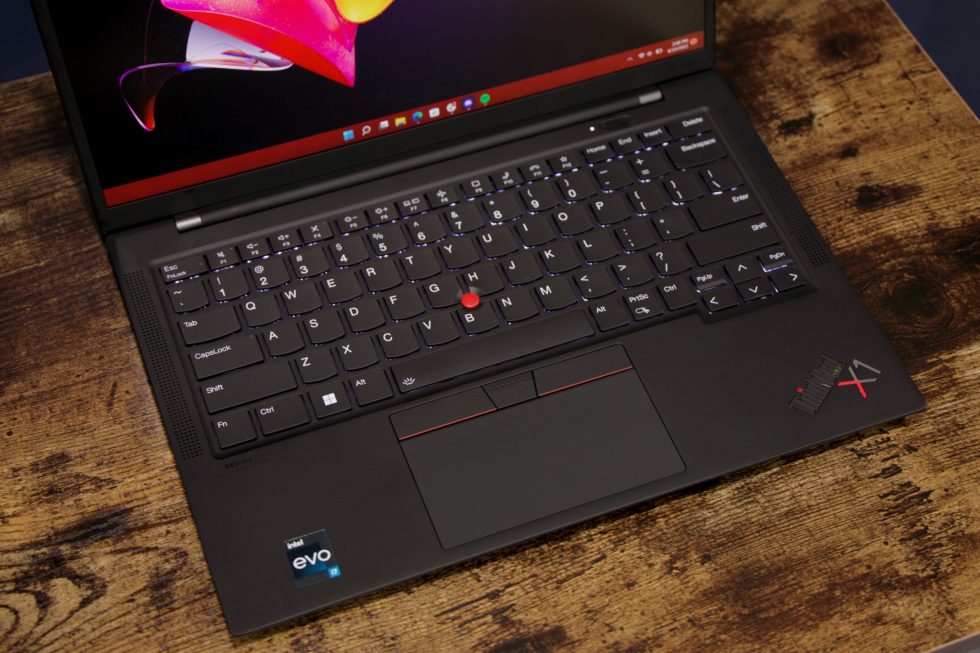
Lenovo gave the X1 Carbon a gentle overhaul from last year's Gen 9 model, swapping out the 16:9 screen for a 16:10 version and ditching Lenovo's semi-proprietary docking port in favor of a pair of plain-old Thunderbolt ports. The Gen 10 model is almost identical—the only physical change I noticed was a slightly raised area above the webcam on the display's bezel, presumably making more room for the upgraded 1080p webcam (the Gen 9 used a 720p model).
For those of you who are less than intimately familiar with the subtleties of the X1 Carbon's design history, the main thing to know is that it takes the classic black angular ThinkPad style and boils it down almost as far as it will go (I say "almost" because the X1 Nano is a thing). It's not as boxy as some of the cheaper L- and E-series ThinkPads, but it's definitely using the same design language that Lenovo and IBM have been refining for 30 years. That is both a blessing and a curse—its sturdy frame and soft-touch finish are pleasant to hold and carry, but it's a hand oil and fingerprint magnet that's hard to keep completely clean.
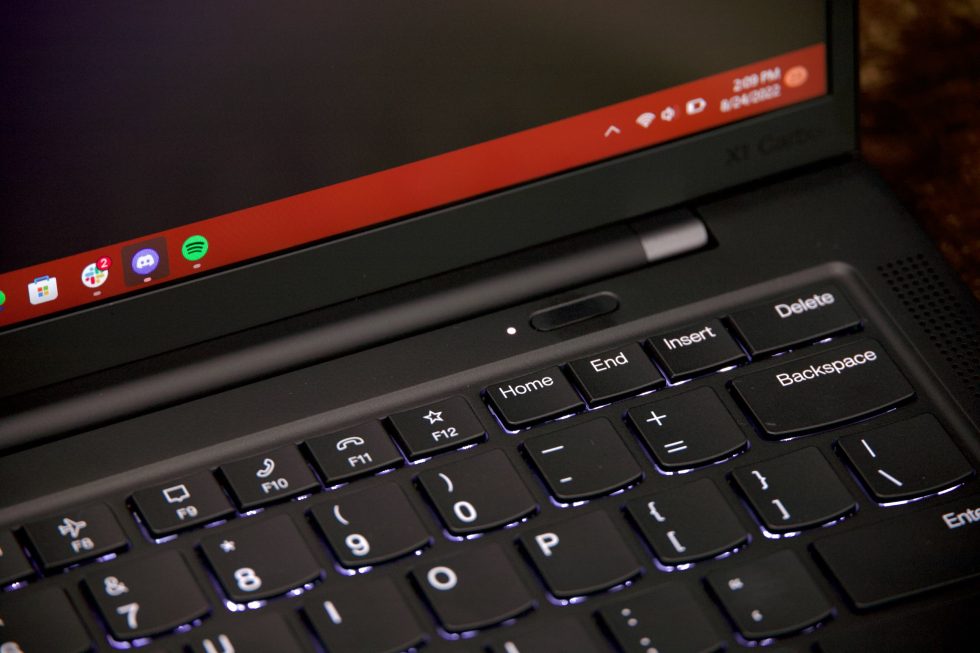
The most important ingredient in any ThinkPad is a top-tier keyboard and trackpad, and the Gen 10 version of the X1 Carbon has both. A large, accurate precision touchpad and a red ThinkPad pointing nub are both included, and both function as intended. The chiclet-style keys are well-spaced and nicely backlit. The keys aren't quite as firm as those in Dell's current XPS models, and I have intermittently been annoyed that the Fn key is to the left of the left Ctrl key instead of the other way around, though this is a longstanding ThinkPad peculiarity that can be corrected in software if you're bothered by it. But by and large it's one of the best keyboards you can get in a laptop right now.
 Ports on the right: a headphone jack and USB-A port.Andrew Cunningham
Ports on the right: a headphone jack and USB-A port.Andrew Cunningham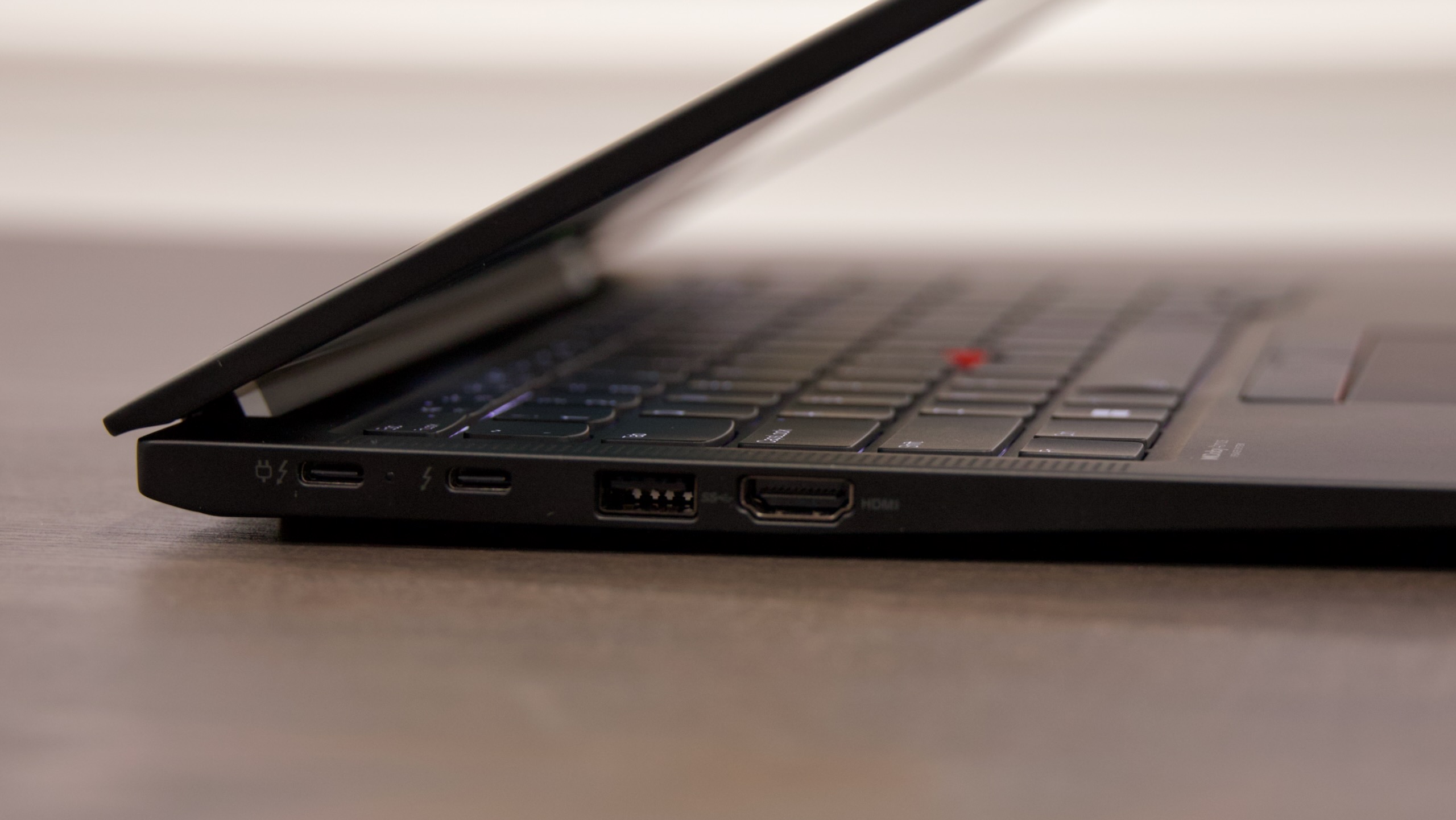 Ports on the left: Two Thunderbolt 4, another USB-A, and full-size HDMI.Andrew Cunningham
Ports on the left: Two Thunderbolt 4, another USB-A, and full-size HDMI.Andrew Cunningham
Port selection remains one of the best arguments for the X1 Carbon over the XPS 13 or even a MacBook Air. The Carbon outdoes both in quantity and variety: a pair of Thunderbolt 4 ports, one of which is used to charge the laptop, plus one USB-A port on either side, a full-size HDMI port, and a headphone jack. The Carbon jettisoned its microSD card reader several generations ago, which is disappointing, and the XPS 13 puts Thunderbolt ports on both sides of the laptop so you can charge it (or plug it into a dock, or whatever) from either side. Laptops with nothing but Thunderbolt/USB-C ports aren't as inconvenient as they used to be, either. But having the extra ports is convenient and useful for anyone who regularly uses external displays or other accessories.
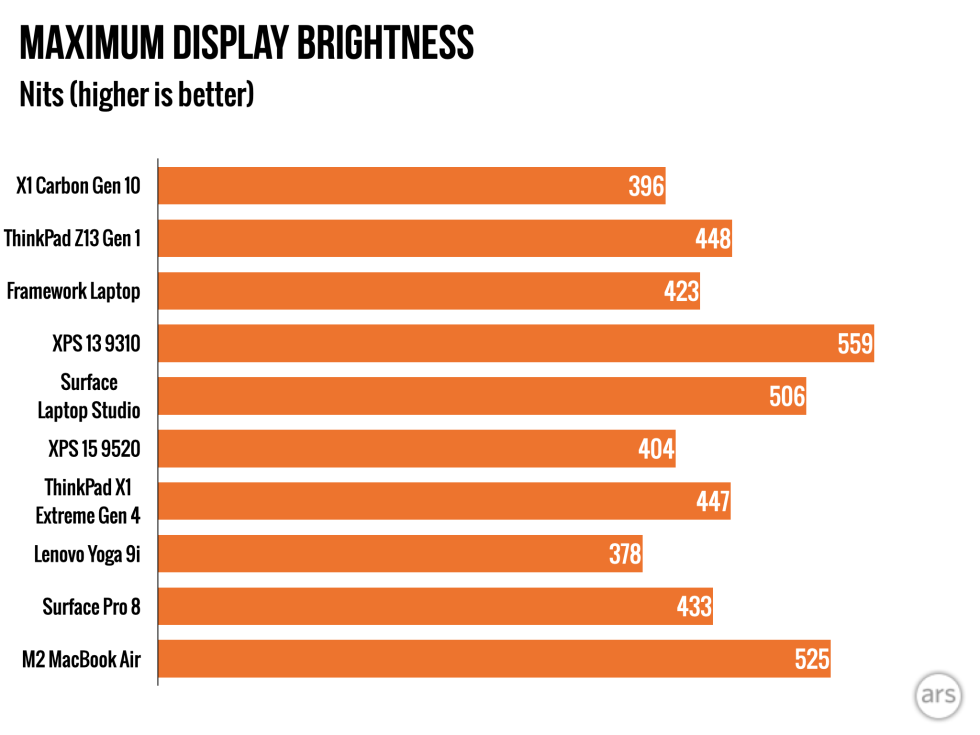
The X1 Carbon can be configured with any one of seven different display panels, including 4K, OLED, privacy-screen, and touchscreen variants; the choice of any of them will subtly change the battery life and weight of the laptop. Our Lenovo-provided review unit uses the 1920×1200 IPS touchscreen, with a maximum brightness of 396 nits, an impressive contrast ratio of 1744:1, and 98 percent sRGB and 71.5 percent DCI-P3 gamut coverage (all as measured by our i1 Display Studio colorimeter). Even the basic screen is bright and colorful, and if you're still using a 16:9 display on an older laptop, you'll find that 120 pixels' worth of extra height makes a surprisingly big difference for usability.
Performance: Good, but complicated
Intel's 12th-gen Alder Lake chips use a mix of larger, faster, and more power-hungry performance cores (P-cores) and smaller, cooler-running efficiency cores (E-cores) to boost performance. As we've seen in our desktop CPU reviews, this usually works well from a performance standpoint—the P-cores ensure good performance in games and other general-use tasks that need small bursts of high speed, while the E-cores can pitch in to help crunch through video encoding jobs and other CPU-heavy tasks. It has been a more mixed bag from a power-usage standpoint. You might think that having "efficiency cores" would help with battery life, but the fact remains that Intel and the PC makers are fitting 12 or 14 physical cores into systems that maxed out at four cores last year.
Lenovo is also using P-series Alder lake CPUs in the X1 Carbon, which have higher P-core counts and TDPs than more typical U-series or G7-series processors that older X1 Carbons have used. This can be either good or great for performance, depending on the settings you're using, though heat can become a problem; we found the same thing in our review of the ThinkPad X1 Yoga.
We tested the X1 Carbon twice, once using Windows' "balanced" power setting and once using the "best performance" setting. For comparison's sake, we did the same thing with last year's X1 Carbon, plus an AMD Ryzen 6000-based ThinkPad Z13. Here are some more detailed specs for the main systems we tested:
- Lenovo's ThinkPad X1 Carbon Gen 10 has a Core i7-1260P (four P-cores, eight E-cores), 16GB of 5200 MHz LPDDR5 RAM, and an Intel Iris Xe integrated GPU with 96 EUs. We tested it in both "Balanced" and in "Best Performance" mode.
- The Lenovo ThinkPad X1 Carbon Gen 9 has a Core i7-1185G7, 16GB of 4267 MHz LPDDR4x, and an Intel Iris Xe integrated GPU with 96 EUs. We tested it in both "Balanced" and in "Best Performance" mode.
- Lenovo's ThinkPad Z13 Gen 1 has an AMD Ryzen 7 Pro 6850U (eight P-cores), 16GB of 6400 MHz LPDDR5 RAM, and an AMD Radeon 680M integrated GPU with 12 GPU cores. We tested it in both "Balanced" and in "Best Performance" mode.
- The Framework Laptop has a Core i7-1280P (six P-cores, eight E-cores), 32GB of 3200 MHz DDR4 RAM, and an Intel Iris Xe integrated GPU with 96 EUs.
- The M2 MacBook Air has an Apple M2 processor (four P-cores, eight E-cores), 16GB of 6400 MHz LPDDR5 RAM, and an Apple-designed GPU with 10 GPU cores.
- Dell's XPS 15 9520 has a Core i7-12700H (six P-cores, eight E-cores), 16GB of 4800 MHz DDR5 RAM, and an Nvidia GeForce 3050 Ti laptop GPU.
- The Surface Laptop Studio has a Core i7-11370H (four P-cores), 16GB of LPDDR4x RAM, and an Nvidia RTX A2000 laptop GPU.
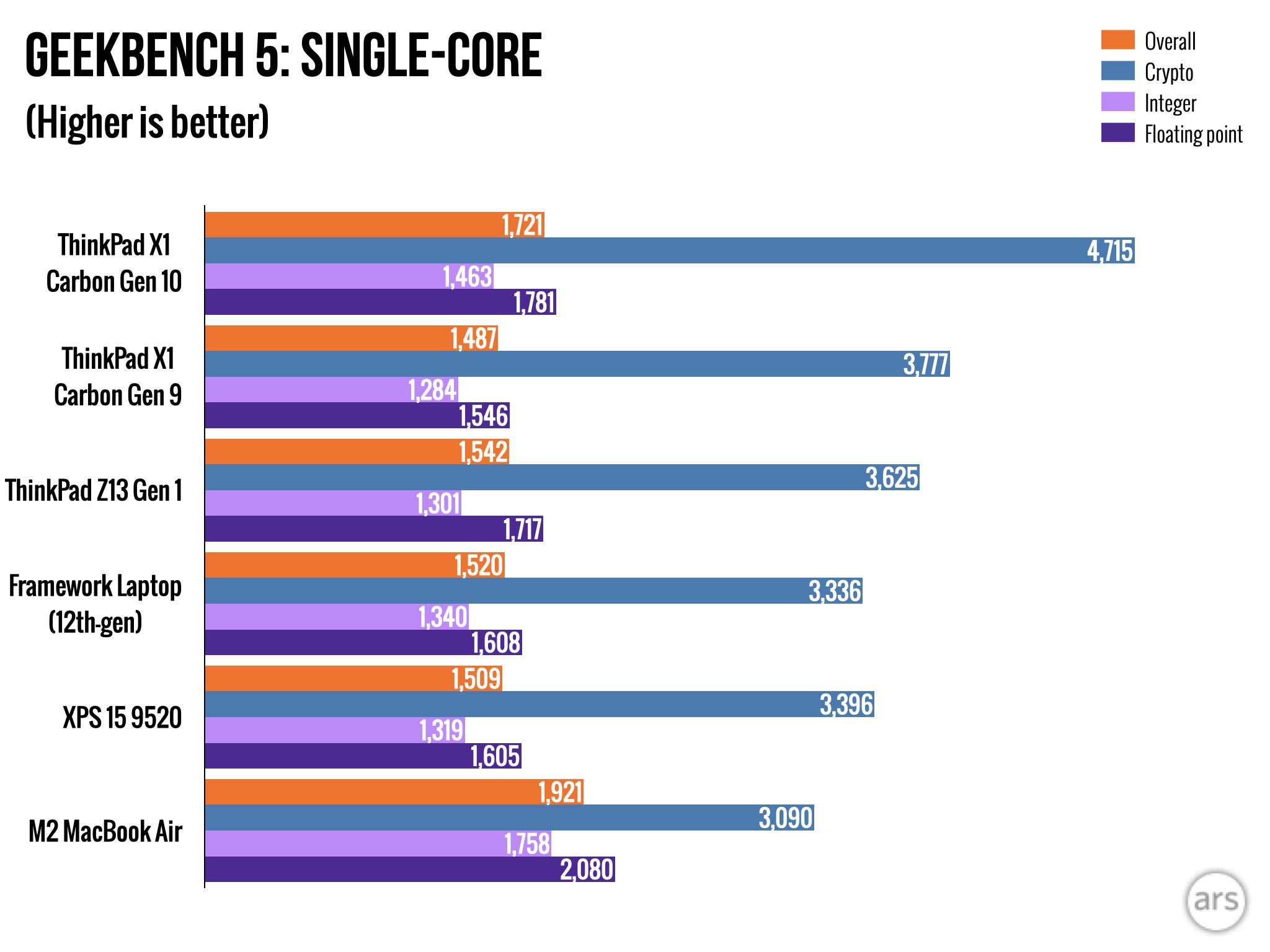 Andrew Cunningham
Andrew Cunningham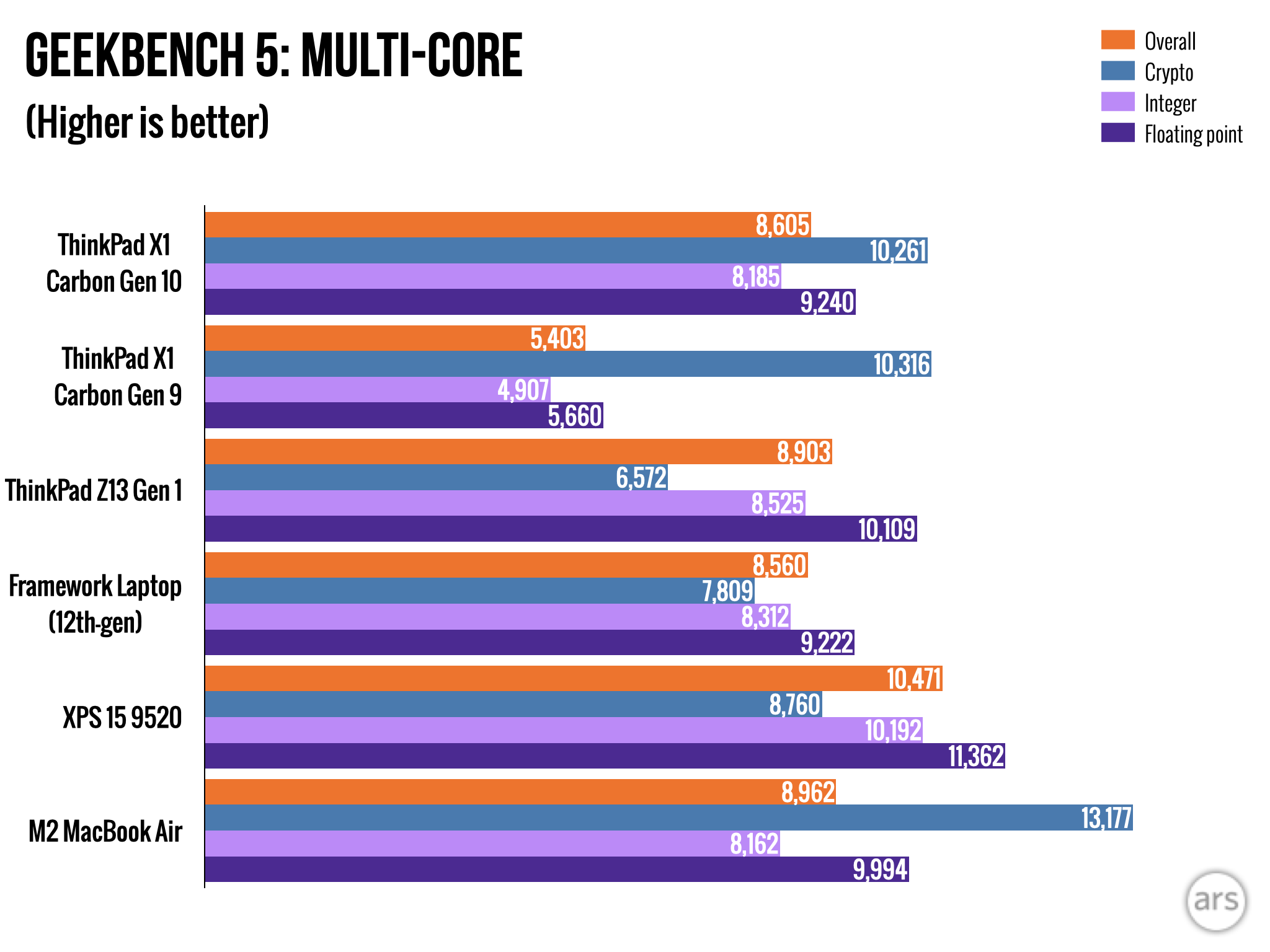 Andrew Cunningham
Andrew Cunningham Andrew Cunningham
Andrew Cunningham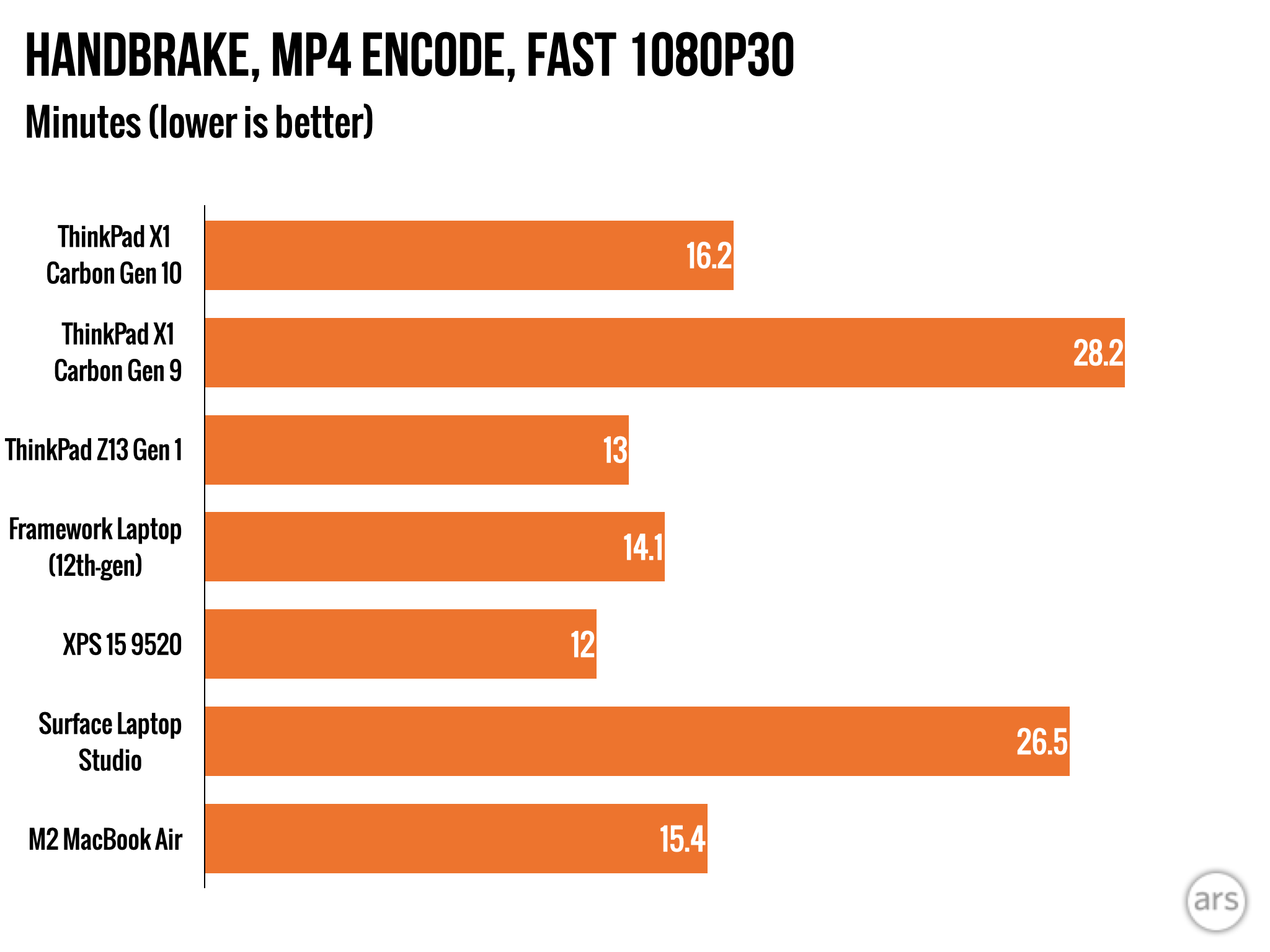 Andrew Cunningham
Andrew Cunningham
When restricted to its "balanced" performance setting, the i7-1260P in the X1 Carbon Gen 10 provides a solid boost to both single- and multi-core performance compared to the i7-1185G7 in last year's X1 Carbon Gen 9. The exception was in our Handbrake video encoding test, which hits all of the CPU cores in a given system for an extended period of time. Despite having many more cores than the old i7-1185G7, the i7-1260P in Balanced mode is actually a bit slower in this test over the long haul, suggesting that Alder Lake is being so power-starved that its cores can't perform to their full potential. The vast majority of the time, this won't be an issue. But it can be an issue if you want to do this kind of work on this laptop.
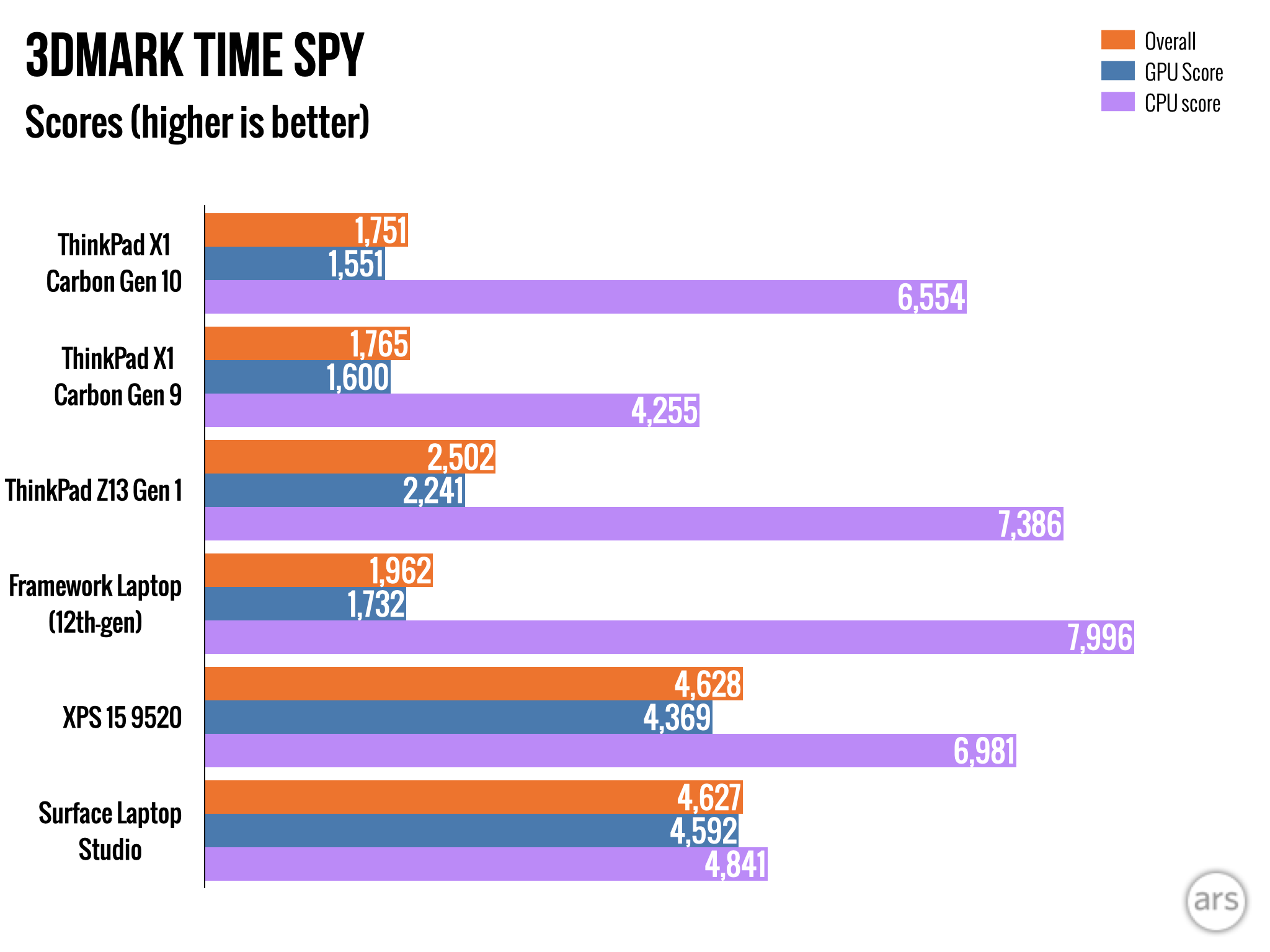 Andrew Cunningham
Andrew Cunningham Andrew Cunningham
Andrew Cunningham
If you play games on this laptop—which the Intel Iris Xe GPU is capable of doing, even though this is by no means a "gaming laptop"—you might also run into this problem. 3DMark performance for the X1 Carbon Gen 10 in "balanced" mode is substantially lower than the X1 Carbon Gen 9, which uses a mostly similar Iris Xe GPU and performs about the same regardless of the power setting you use. But in "best performance" mode, the overall and GPU-based scores for the X1 Carbon Gen 10 are nearly identical to the Gen 9's scores, even though the CPU subscore goes up quite a bit. (All this means is that most games will be bottlenecked by the integrated GPU, as long as the CPU is getting enough power to run at full speeds.)
 Andrew Cunningham
Andrew Cunningham Andrew Cunningham
Andrew Cunningham Andrew Cunningham
Andrew Cunningham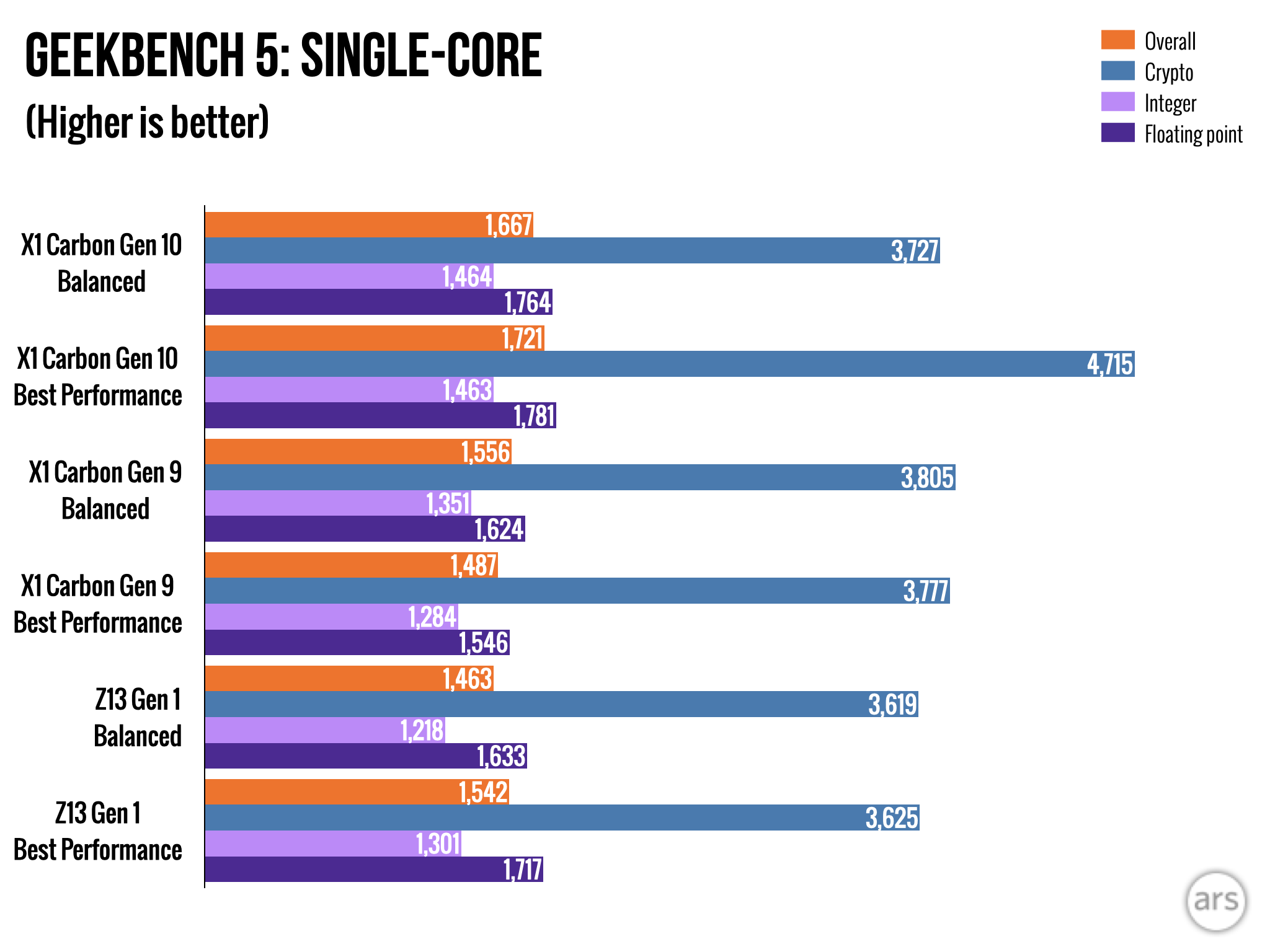 Andrew Cunningham
Andrew Cunningham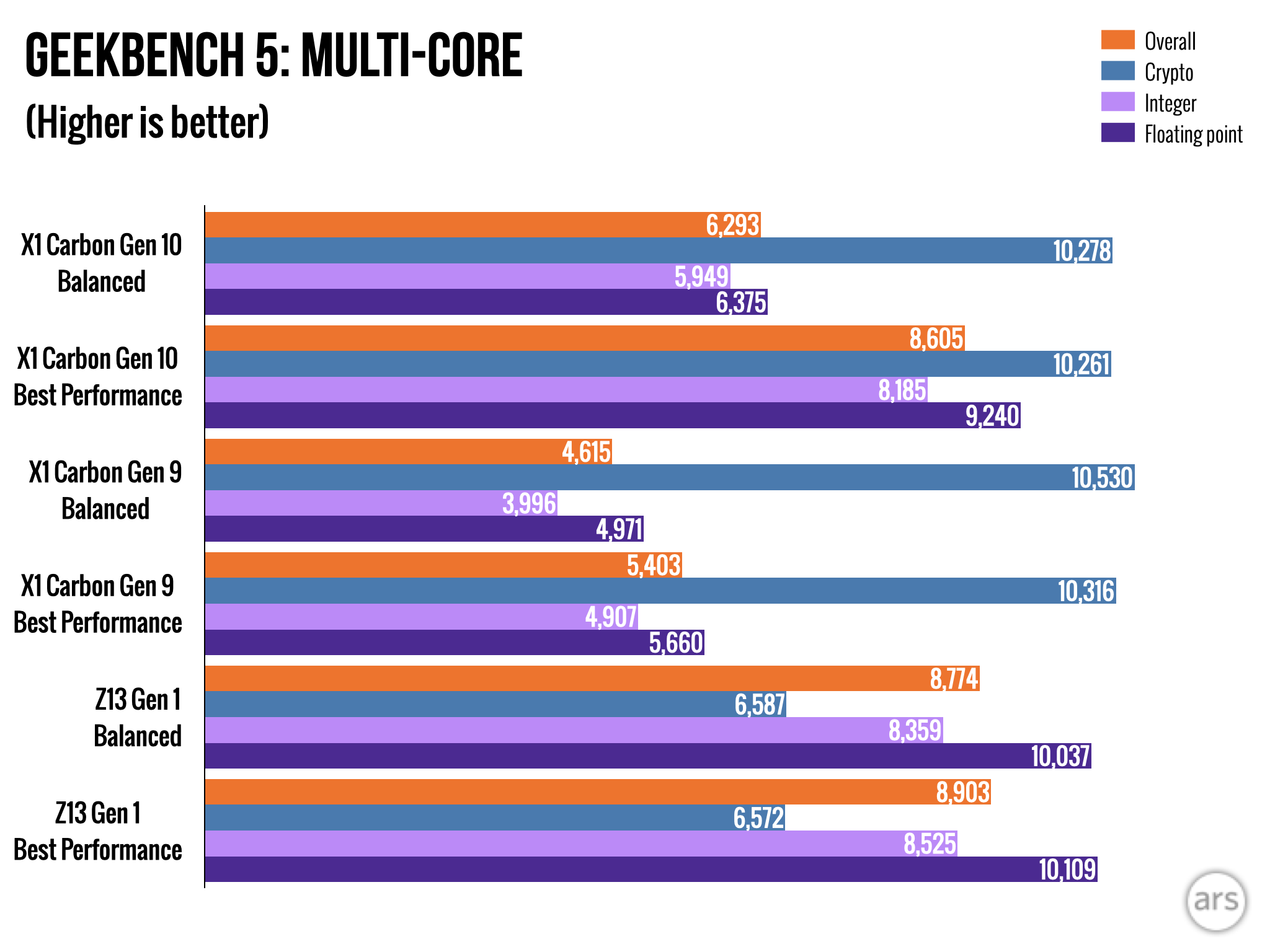 Andrew Cunningham
Andrew Cunningham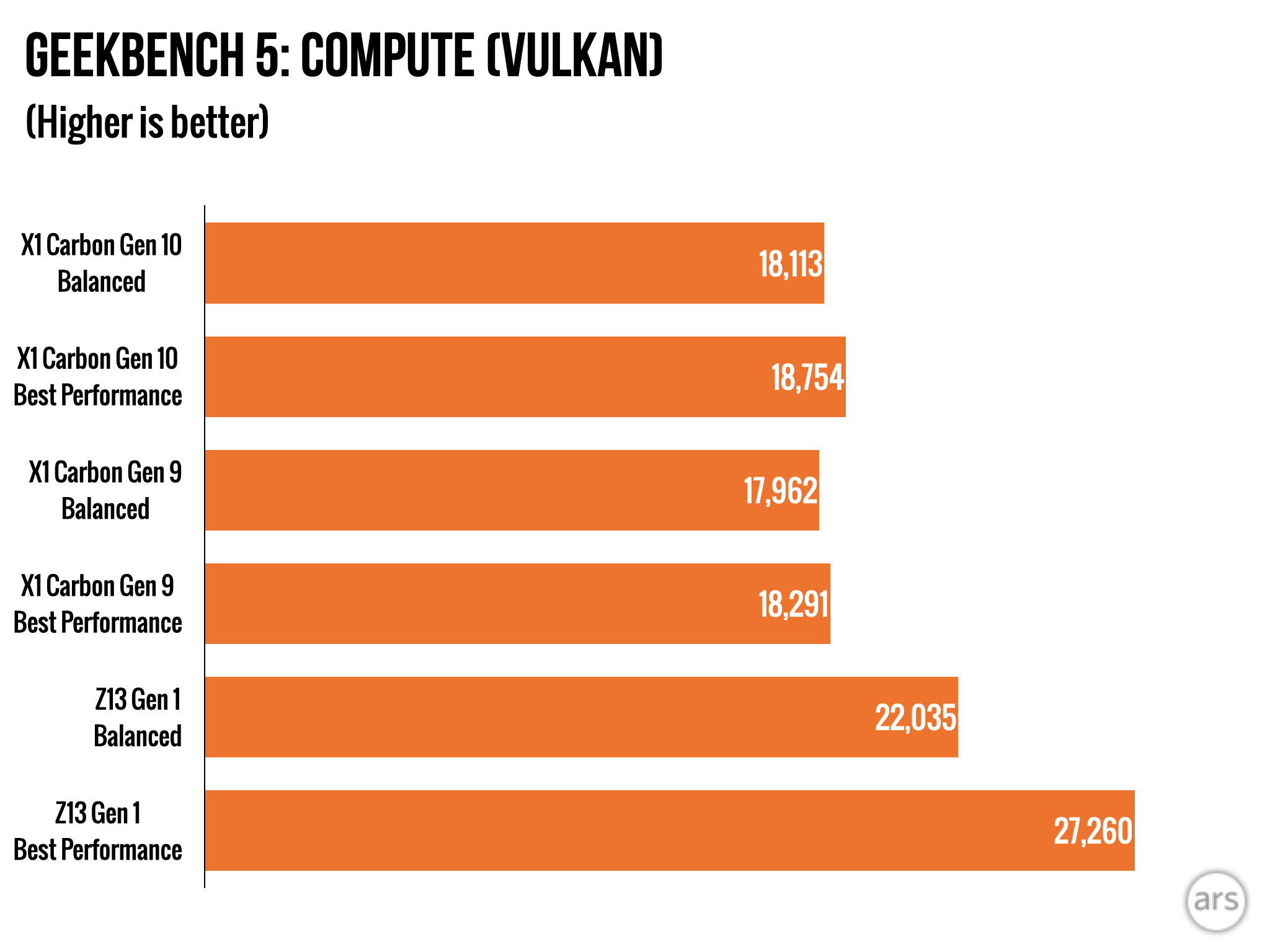 Andrew Cunningham
Andrew Cunningham
In fact, looking at the "best performance" numbers, it becomes clear that Alder Lake becomes dramatically faster when fed a bit more power. This is true across the board, from very light tests like Geekbench (which rarely if ever runs for long enough to trigger much throttling) to heavier ones like Cinebench and Handbrake. Toggling between the two power presets makes a much larger difference than it does for the X1 Carbon Gen 9 or the Z13. Performance actually doubles in the Handbrake test for the i7-1260P, where it stays pretty much exactly the same for the i7-1185G7.
The short version of all of this is that the X1 Carbon Gen 10's performance is "good, but it's complicated." Most of the time, it will be faster than its predecessor regardless of the power settings you use, but that's not uniformly true across the board, particularly in sustained workloads like video editing and encoding, gaming, and CPU-heavy rendering tasks. To beat the last-gen X1 Carbon at these kinds of things, you'll need to switch on "best performance" mode and deal with the accompanying increase in power consumption and heat.
Battery life: OK, but diminished
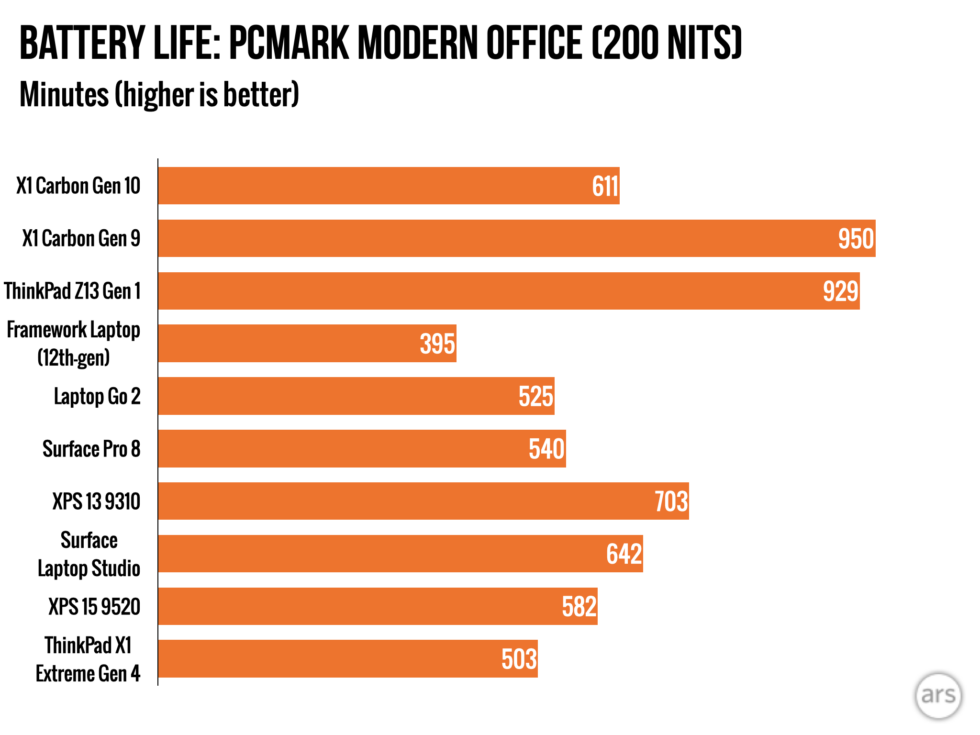
But the real problem for most ultraportable laptop buyers is battery life. The X1 Carbon Gen 10 does fine in our PCMark-based battery test, at around 10 hours, and toggling between "balanced" and "best performance" didn't really make a difference in the results (but that's more because the test doesn't include sustained workloads, so the CPU is spending more time idling—battery life would assuredly be lower if you were playing a game or doing something else strenuous). That's better than a lot of options in this category, including the Surface Pro 8 and the battery-challenged Framework Laptop.
But as with the Framework Laptop, the Alder Lake version of the X1 Carbon just doesn't last as long as the version of the exact same laptop with Intel's 11th-generation chips inside—and I ran this test on both laptops in both power modes at least three times apiece to confirm that the yawning gap between the last-gen and current-gen laptops wasn't some kind of fluke. Tellingly, Lenovo's own tech specs page for older X1 Carbon laptops (I checked the Gen 7, Gen 8, and Gen 9) include manufacturer-provided MobileMark battery life scores, while the page for the Gen 10 doesn't. There could be a lot of explanations for this, although given our testing it seems like Lenovo might just be trying to avoid unflattering comparisons.
However efficient the E-cores are, it just seems like the baseline power consumption of all those cores is higher than it was for 11th-gen chips, at least in laptops that move up to P-series chips with higher TDPs (and for the most prominent 12th-gen Ultrabooks, that's most of them). As good as the performance benefits of Alder Lake can be—and they really are transformative for CPU-heavy work—in the context of an ultraportable laptop, giving up a full third of your battery life in exchange for high-end multi-threaded CPU performance feels like the wrong tradeoff.
A flawed version of a great laptop
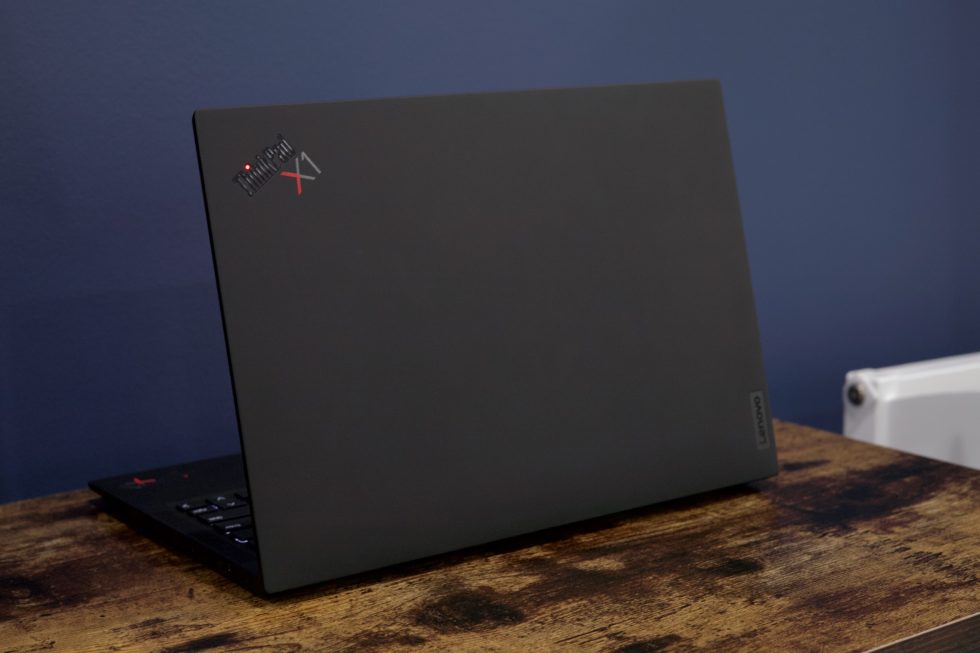
The X1 Carbon Gen 10 is still a great laptop, same as with most of the X1 Carbon versions over the last decade. But the reduced battery life is too bad, and it keeps us from recommending it as enthusiastically as we have in years past.
The Gen 9 and Gen 10 models share so many similarities—same basic design, same battery capacity, same screen options—that it's easy to lay the blame for the battery problems on the processor. It may be that the lower-end X1 Carbon models with the Core i5-1235U would behave better when unplugged, but the higher-power i7-1260P in our test model definitely did poorly. These P-series chips ship in the vast majority of all X1 Carbon Gen 10 configs, and taken together with the also-poor results from the newest Framework Laptop, their increased performance seems to come at a cost.
This is doubly concerning because there are other options out there that aren't asking you to make the same tradeoffs. We'll be giving it a more thorough review shortly, but Lenovo's ThinkPad Z13 uses a Ryzen 6000 processor that's faster than most of Intel's 12th-gen CPUs in every single way, and it has fantastic battery life to boot (Lenovo doesn't make an AMD version of the X1 Carbon, but the ThinkPad T14s Gen 3 comes close). And if you want to look over the fence into Apple-land, the company's M2 MacBook Air is usually a match for the i7-1260P in Best Performance mode—but in a fanless laptop that also has great battery life.
The X1 Carbon Gen 10 still has commendable qualities—its light weight, its great keyboard and trackpad, its 14-inch screen, its USB-A and HDMI ports—but it might be best to skip this year's model or even to pick up a discounted Gen 9 version instead if you aren't doing CPU-heavy work on your laptop. It's not as fast, but for people who spend lots of time away from an outlet, its balance of performance and battery life is a better fit.
The good
- A truly great ultraportable laptop design, with a large screen, light weight, a decent port selection, and a comfortable keyboard and trackpad.
- Usually performs better than its predecessor and can perform much better using the Best Performance power preset.
- A 16:10 screen with lots of configuration options, including OLED and 4K.
- Even the baseline 1920×1200 display looks nice.
- Upgraded 1080p webcam with handy privacy shutter.
- Good documentation for repairs (although, like most thin-and-light laptop designs, many components can't be upgraded).
The bad
- Larger-than-usual gap (and tradeoffs) between Balanced and Best Performance modes.
- 12th-gen Intel CPU's performance can sometimes be slower than its predecessor under the Balanced power preset.
- No GPU performance upgrade since last year and can perform worse in Balanced mode.
- Pricey.
The ugly
- Significant battery downgrade from similarly configured last-gen model.
Ars Technica may earn compensation for sales from links on this post through affiliate programs.
Listing image by Andrew Cunningham
Technology - Latest - Google News
August 26, 2022 at 10:38PM
https://ift.tt/sZRfuiw
Lenovo ThinkPad X1 Carbon Gen 10 review: A fast-but-flawed version of a great laptop - Ars Technica
Technology - Latest - Google News
https://ift.tt/oIC3s4G

No comments:
Post a Comment